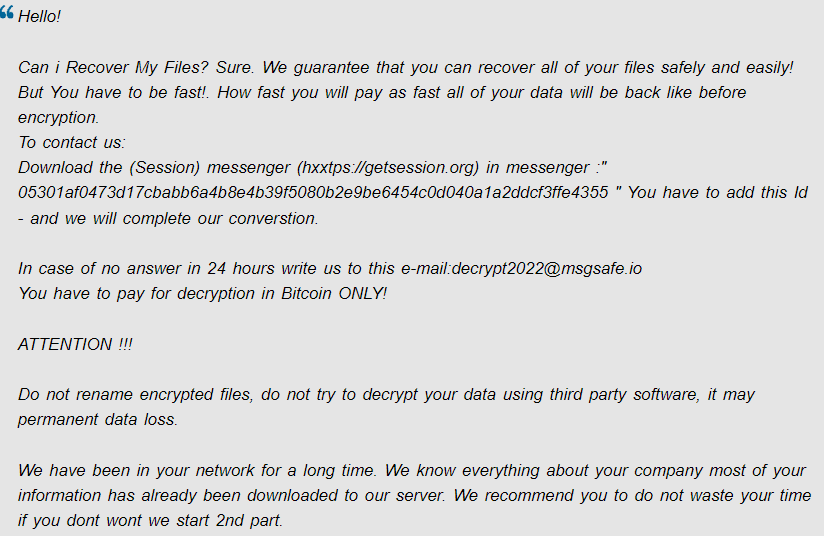What is Oori ransomware virus
The ransomware known as Oori ransomware is classified as a very harmful threat, due to the amount of damage it might cause. It is possible you have never ran into this type of malware before, in which case, you might be especially surprised. Your data may have been encoded using strong encryption algorithms, making you unable to access them anymore. File encoding malicious software is believed to be such a dangerous contamination because file decryption isn’t necessarily possible in all cases.
Criminals will offer you a decryptor but complying with the requests may not be the greatest idea. First of all, paying won’t ensure file decryption. We would be shocked if cyber criminals didn’t just take your money and feel obligated to help you with recovering data. That money would also finance future activities of these crooks. It is already supposed that file encoding malware did billions worth of damage to businesses in 2017, and that’s an estimation only. The more people pay, the more profitable it becomes, thus luring more malicious people to it. You could be put into this type of situation again in the future, so investing the demanded money into backup would be a wiser choice because you would not need to worry about losing your data. If you did have backup before your device got contaminated, fix Oori ransomware and recover files from there. You will find info on how file encoding malware spreads and how to avoid it in the below paragraph.
Ransomware distribution ways
Email attachments, exploit kits and malicious downloads are the distribution methods you need to be cautious about the most. Seeing as these methods are still rather popular, that means that people are pretty negligent when they use email and download files. That’s not to say more sophisticated methods aren’t popular, however. Criminals attach an infected file to an email, write a semi-plausible text, and falsely claim to be from a credible company/organization. Because the topic is sensitive, people are more inclined to open money-related emails, thus those kinds of topics may frequently be encountered. It’s quite often that you will see big names like Amazon used, for example, if Amazon emailed someone a receipt for a purchase that the user does not recall making, he/she would open the attachment immediately. There are certain signs you need to look out for before opening email attachments. It’s essential that you check the sender to see whether they are familiar to you and if they’re trustworthy. Even if you know the sender, don’t rush, first check the email address to make sure it matches the address you know belongs to that person/company. The emails also often contain grammar errors, which tend to be pretty evident. Another rather obvious sign is your name not used in the greeting, if a real company/sender were to email you, they would definitely use your name instead of a typical greeting, referring to you as Customer or Member. Vulnerabilities on your system Out-of-date programs might also be used to infect. All software have vulnerabilities but when they’re discovered, they are frequently patched by software makes so that malware can’t take advantage of it to infect. Unfortunately, as as could be seen by the widespread of WannaCry ransomware, not everyone installs those patches, for various reasons. We suggest that you update your programs, whenever a patch is released. Patches could install automatically, if you don’t wish to bother with them every time.
What can you do about your data
When a file encoding malicious program manages to enter your computer, you will soon find your data encrypted. Even if infection wasn’t obvious initially, it’ll become pretty obvious something is wrong when you can’t open your files. Check the extensions added to encrypted files, they ought to show the name of the ransomware. Sadly, files may be permanently encoded if the data encoding malware used powerful encryption algorithms. If you’re still not sure what’s going on, everything will be explained in the ransom note. According to the criminals, you will be able to restore data via their decryption program, which will obviously not come for free. The ransom amount should be specified in the note, but sometimes, cyber criminals request victims to send them an email to set the price, it may range from some tens of dollars to a couple of hundred. As you already know, paying isn’t the option we would suggest. Try out every other likely option, before even thinking about giving into the requests. Maybe you have just forgotten that you’ve made copies of your files. A free decryption program may also be an option. Sometimes malware specialists are able to crack the file encoding malicious program, which means you may get a decryption program for free. Take that option into account and only when you are entirely sure a free decryptor is not available, should you even consider complying with the demands. You would not have to worry if you ever end up in this situation again if you invested some of that sum into purchase backup with that money. If your most important files are stored somewhere, you just remove Oori ransomware virus and then recover files. In the future, at least try to make sure you avoid ransomware and you can do that by becoming familiar with how it is distributed. Stick to legitimate websites when it comes to downloads, be vigilant when opening files attached to emails, and ensure programs are up-to-date.
Oori ransomware removal
If the file encrypting malware stays on your device, we encourage acquiring a malware removal software to get rid of it. It may be quite difficult to manually fix Oori ransomware virus because a mistake could lead to additional harm. A malware removal utility would be a more safer choice in this case. The software would not only help you deal with the infection, but it might stop future ransomware from entering. So look into what matches what you require, install it, have it scan the computer and once the data encoding malicious software is located, get rid of it. We should say that a malware removal utility will only terminate the infection, it won’t aid in file decrypting. If the ransomware has been eliminated entirely, recover your data from where you are keeping them stored, and if you don’t have it, start using it.
Offers
Download Removal Toolto scan for Oori ransomwareUse our recommended removal tool to scan for Oori ransomware. Trial version of provides detection of computer threats like Oori ransomware and assists in its removal for FREE. You can delete detected registry entries, files and processes yourself or purchase a full version.
More information about SpyWarrior and Uninstall Instructions. Please review SpyWarrior EULA and Privacy Policy. SpyWarrior scanner is free. If it detects a malware, purchase its full version to remove it.

WiperSoft Review Details WiperSoft (www.wipersoft.com) is a security tool that provides real-time security from potential threats. Nowadays, many users tend to download free software from the Intern ...
Download|more


Is MacKeeper a virus? MacKeeper is not a virus, nor is it a scam. While there are various opinions about the program on the Internet, a lot of the people who so notoriously hate the program have neve ...
Download|more


While the creators of MalwareBytes anti-malware have not been in this business for long time, they make up for it with their enthusiastic approach. Statistic from such websites like CNET shows that th ...
Download|more
Quick Menu
Step 1. Delete Oori ransomware using Safe Mode with Networking.
Remove Oori ransomware from Windows 7/Windows Vista/Windows XP
- Click on Start and select Shutdown.
- Choose Restart and click OK.

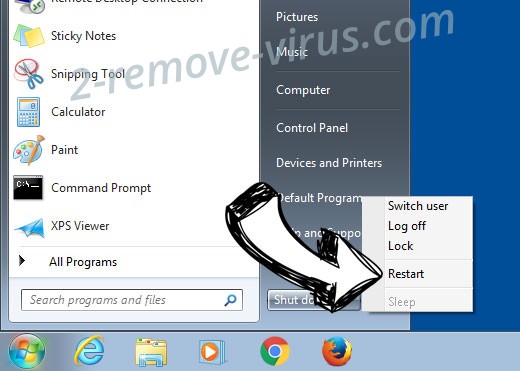
- Start tapping F8 when your PC starts loading.
- Under Advanced Boot Options, choose Safe Mode with Networking.

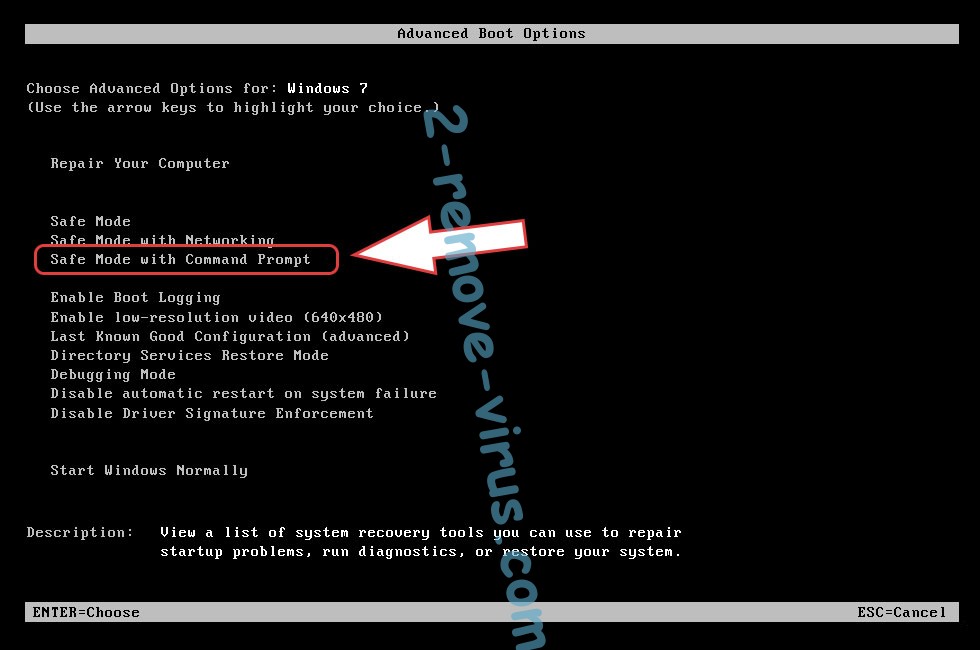
- Open your browser and download the anti-malware utility.
- Use the utility to remove Oori ransomware
Remove Oori ransomware from Windows 8/Windows 10
- On the Windows login screen, press the Power button.
- Tap and hold Shift and select Restart.

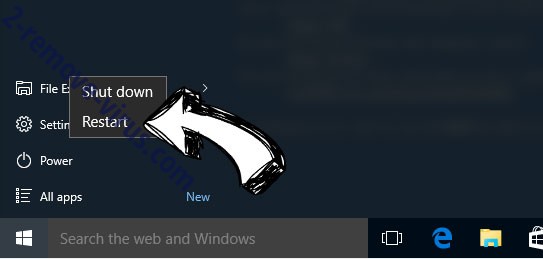
- Go to Troubleshoot → Advanced options → Start Settings.
- Choose Enable Safe Mode or Safe Mode with Networking under Startup Settings.

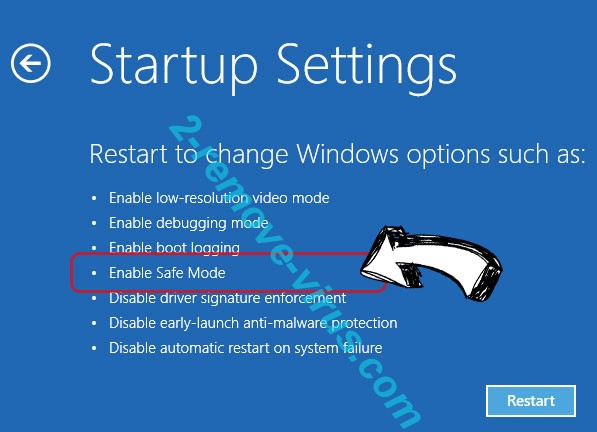
- Click Restart.
- Open your web browser and download the malware remover.
- Use the software to delete Oori ransomware
Step 2. Restore Your Files using System Restore
Delete Oori ransomware from Windows 7/Windows Vista/Windows XP
- Click Start and choose Shutdown.
- Select Restart and OK


- When your PC starts loading, press F8 repeatedly to open Advanced Boot Options
- Choose Command Prompt from the list.

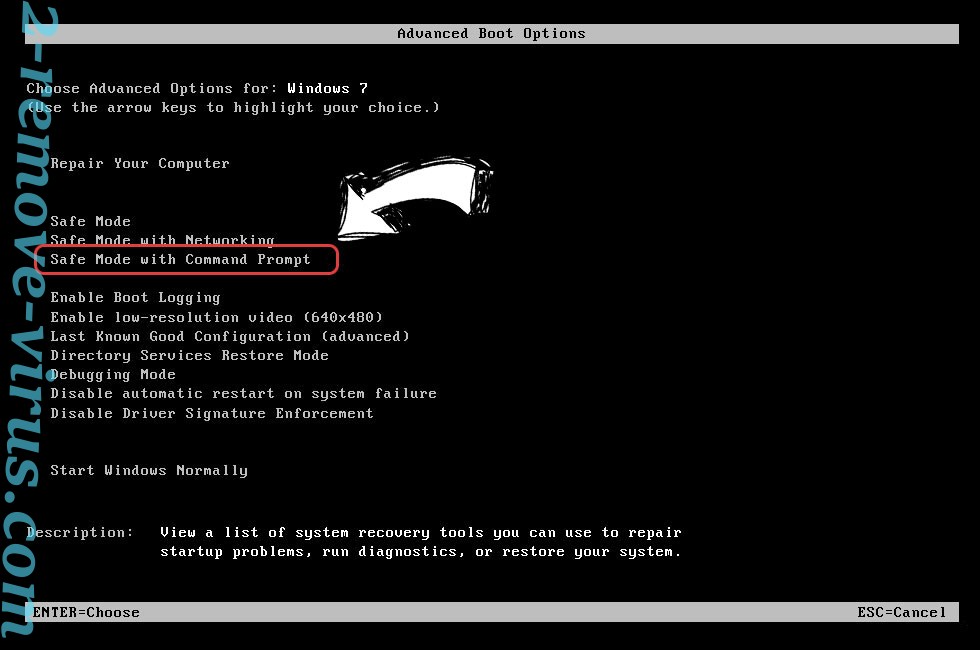
- Type in cd restore and tap Enter.

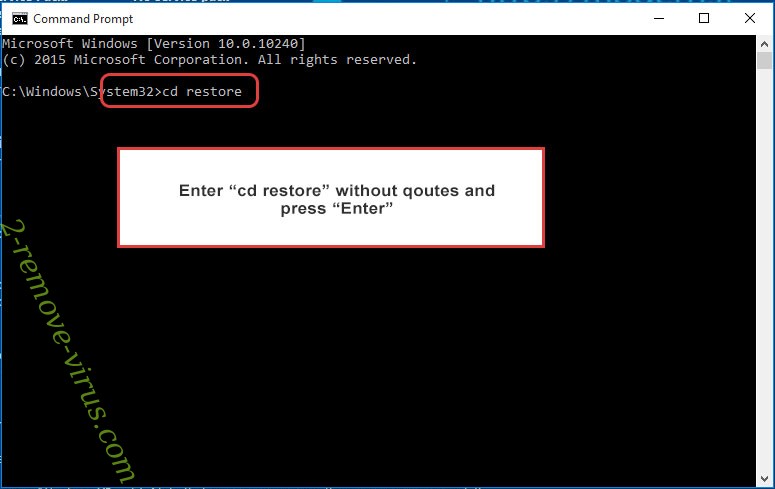
- Type in rstrui.exe and press Enter.

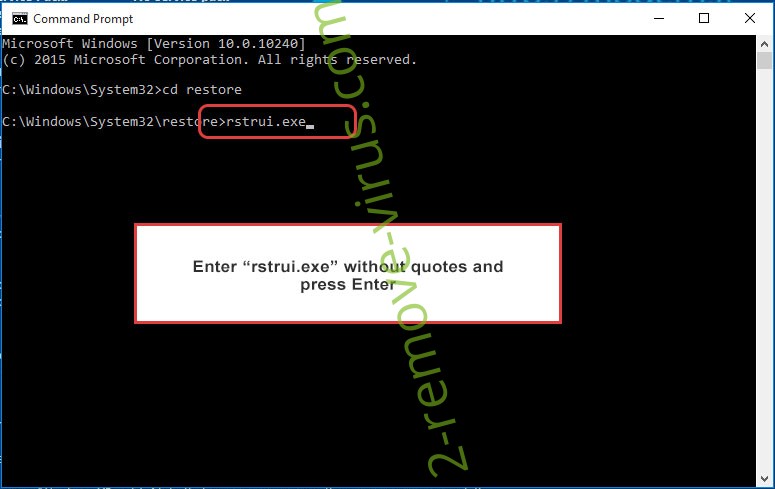
- Click Next in the new window and select the restore point prior to the infection.

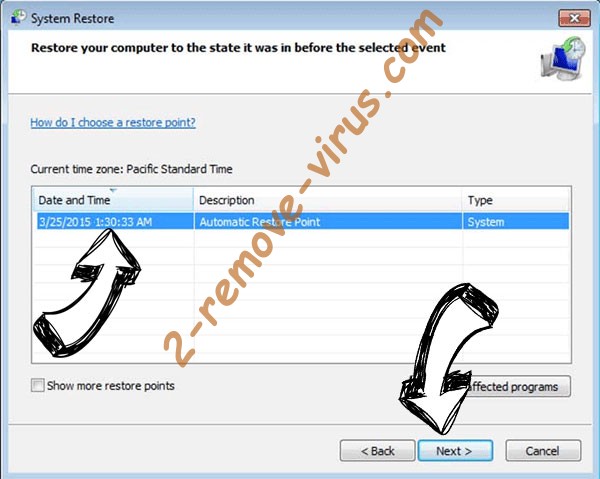
- Click Next again and click Yes to begin the system restore.

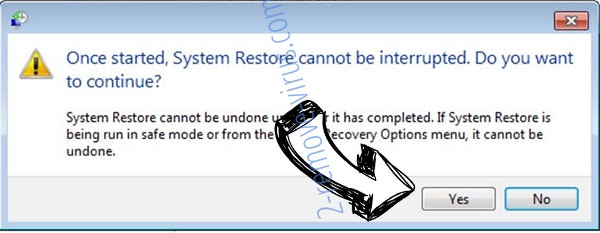
Delete Oori ransomware from Windows 8/Windows 10
- Click the Power button on the Windows login screen.
- Press and hold Shift and click Restart.


- Choose Troubleshoot and go to Advanced options.
- Select Command Prompt and click Restart.

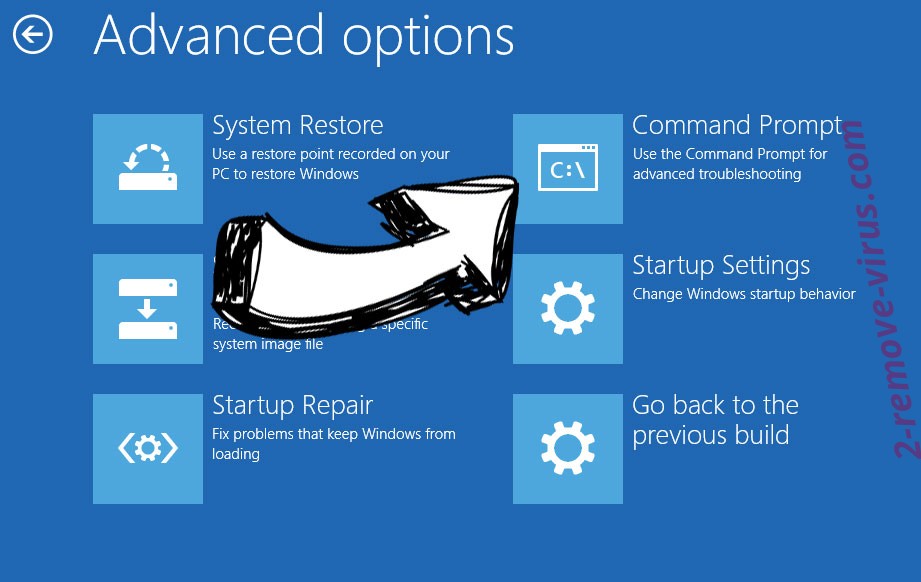
- In Command Prompt, input cd restore and tap Enter.


- Type in rstrui.exe and tap Enter again.


- Click Next in the new System Restore window.

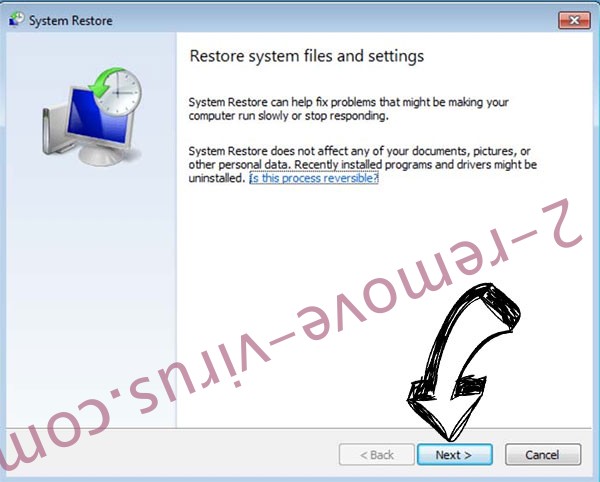
- Choose the restore point prior to the infection.


- Click Next and then click Yes to restore your system.


Site Disclaimer
2-remove-virus.com is not sponsored, owned, affiliated, or linked to malware developers or distributors that are referenced in this article. The article does not promote or endorse any type of malware. We aim at providing useful information that will help computer users to detect and eliminate the unwanted malicious programs from their computers. This can be done manually by following the instructions presented in the article or automatically by implementing the suggested anti-malware tools.
The article is only meant to be used for educational purposes. If you follow the instructions given in the article, you agree to be contracted by the disclaimer. We do not guarantee that the artcile will present you with a solution that removes the malign threats completely. Malware changes constantly, which is why, in some cases, it may be difficult to clean the computer fully by using only the manual removal instructions.
